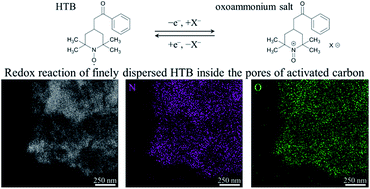当前位置:
X-MOL 学术
›
Sustain. Energy Fuels
›
论文详情
Our official English website, www.x-mol.net, welcomes your feedback! (Note: you will need to create a separate account there.)
Non-polymeric hybridization of a TEMPO derivative with activated carbon for high-energy-density aqueous electrochemical capacitor electrodes†
Sustainable Energy & Fuels ( IF 5.6 ) Pub Date : 2018-01-08 00:00:00 , DOI: 10.1039/c7se00541e Hiroyuki Itoi 1, 2, 3, 4 , Hideyuki Hasegawa 1, 2, 3, 4 , Hiroyuki Iwata 2, 3, 4, 5 , Yoshimi Ohzawa 1, 2, 3, 4
Sustainable Energy & Fuels ( IF 5.6 ) Pub Date : 2018-01-08 00:00:00 , DOI: 10.1039/c7se00541e Hiroyuki Itoi 1, 2, 3, 4 , Hideyuki Hasegawa 1, 2, 3, 4 , Hiroyuki Iwata 2, 3, 4, 5 , Yoshimi Ohzawa 1, 2, 3, 4
Affiliation

|
Organic compounds have great potential as electrode materials with high energy and power densities, together with long cycle lifetimes. These properties can be achieved by employing redox-active organic compounds and porous carbon substrates via well-suited hybridization methods. In this study, a 2,2,6,6-tetramethylpiperidine-N-oxyl (TEMPO) derivative, 4-hydroxy-TEMPO benzoate (HTB), was used as an electrode material for aqueous electrochemical capacitors due to its high redox potential characteristics to achieve high energy densities. The hybridization of HTB and activated carbon (AC) was accomplished simply by adsorbing HTB in AC via a solvent-free preparation. This procedure takes only one hour and enables achieving precise AC/HTB weight ratios, eliminating the excess use of HTB or the use of organic solvents. Of note in this method is that it is not necessary to introduce HTB molecules in polymer chains to prevent dissolution of HTB in an aqueous electrolyte with the aid of a hydrophobic group in HTB. HTB molecules are finely dispersed inside the AC pores and therefore present a huge contact area with a conductive carbon surface, allowing for fast redox reactions (i.e., high power densities) in aqueous 1 M H2SO4 despite HTB displaying poor electrical conductivity by itself. As a result, the obtained AC/HTB materials enable compatibility of high energy and power densities.
中文翻译:

TEMPO衍生物与活性炭的非聚合杂交,用于高能量密度水性电化学电容器电极†
有机化合物作为具有高能量和功率密度以及长循环寿命的电极材料具有巨大的潜力。这些特性可以通过适当的杂交方法通过使用氧化还原活性有机化合物和多孔碳底物来实现。在这项研究中,由于2,2,6,6-四甲基哌啶-N-氧基(TEMPO)衍生物4-羟基-TEMPO苯甲酸酯(HTB)由于其高氧化还原电位特性而被用作水性电化学电容器的电极材料。实现高能量密度。通过简单地通过将HTB吸附在AC中来完成HTB和活性炭(AC)的杂交无溶剂的制剂。此过程仅需一个小时,就可以实现精确的AC / HTB重量比,从而避免了过多使用HTB或使用有机溶剂。在该方法中值得注意的是,不必在聚合物链中引入HTB分子以防止HTB借助于HTB中的疏水基团溶解在水性电解质中。HTB分子精细地分散在AC孔内,因此与导电碳表面存在巨大的接触面积,尽管HTB本身显示出较差的电导率,但仍可在1 MH 2 SO 4水溶液中进行快速的氧化还原反应(即,高功率密度)。结果,所获得的AC / HTB材料能够实现高能量和功率密度的兼容性。
更新日期:2018-01-08
中文翻译:

TEMPO衍生物与活性炭的非聚合杂交,用于高能量密度水性电化学电容器电极†
有机化合物作为具有高能量和功率密度以及长循环寿命的电极材料具有巨大的潜力。这些特性可以通过适当的杂交方法通过使用氧化还原活性有机化合物和多孔碳底物来实现。在这项研究中,由于2,2,6,6-四甲基哌啶-N-氧基(TEMPO)衍生物4-羟基-TEMPO苯甲酸酯(HTB)由于其高氧化还原电位特性而被用作水性电化学电容器的电极材料。实现高能量密度。通过简单地通过将HTB吸附在AC中来完成HTB和活性炭(AC)的杂交无溶剂的制剂。此过程仅需一个小时,就可以实现精确的AC / HTB重量比,从而避免了过多使用HTB或使用有机溶剂。在该方法中值得注意的是,不必在聚合物链中引入HTB分子以防止HTB借助于HTB中的疏水基团溶解在水性电解质中。HTB分子精细地分散在AC孔内,因此与导电碳表面存在巨大的接触面积,尽管HTB本身显示出较差的电导率,但仍可在1 MH 2 SO 4水溶液中进行快速的氧化还原反应(即,高功率密度)。结果,所获得的AC / HTB材料能够实现高能量和功率密度的兼容性。



























 京公网安备 11010802027423号
京公网安备 11010802027423号